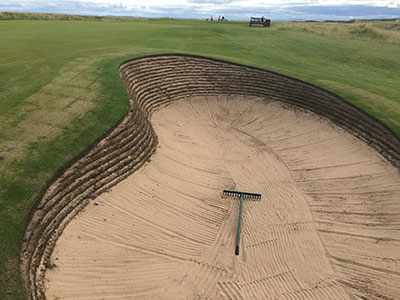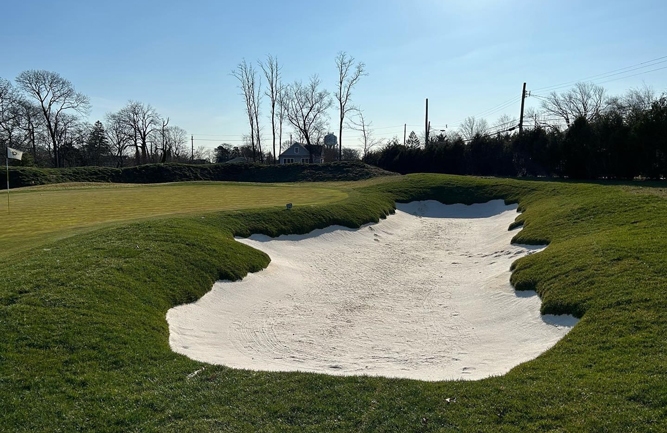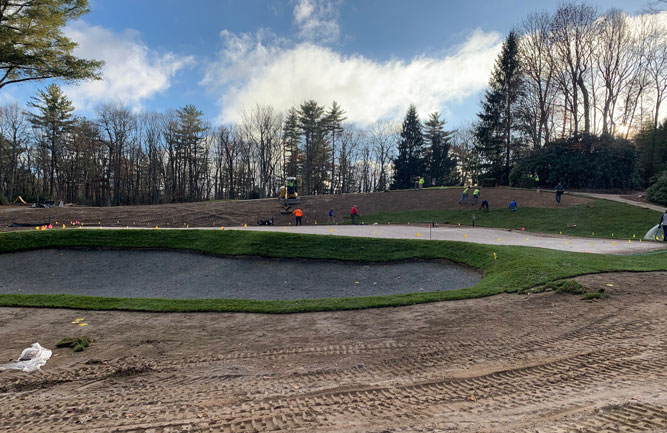Bunker renovation 101
 Bunkers, like all physical features on golf courses, show signs of aging over time. Golf is an outdoor sport, and bunkers are affected by numerous conditions, including dust storms, wind, rain, animal contamination, golfers and maintenance workers. Consistency between bunkers also begins to change. These outside influences also affect sand color, again causing inconsistency.
Bunkers, like all physical features on golf courses, show signs of aging over time. Golf is an outdoor sport, and bunkers are affected by numerous conditions, including dust storms, wind, rain, animal contamination, golfers and maintenance workers. Consistency between bunkers also begins to change. These outside influences also affect sand color, again causing inconsistency.
Bunkers are like greens and tees in that they tend to shrink over time, causing original contoured edges to change. This change affects bunker appearance, but also potentially affects playability.
As much effort as your maintenance staff puts into the bunkers to look and play consistently, they always continue to show signs of aging. Some courses just add more sand to get the color and consistency right. However, by doing this, most bunkers end up containing too much sand because no old sand is removed. This also affects playability and changes the original design as well as the strategy for playing out of these bunkers.
Most courses stretch out rebuilding bunkers as long as they can because they don’t have the resources to complete all bunkers at the same time. Again, this leads to inconsistency. When rebuilding bunkers one-off, it’s difficult to get the new sand firm and color-consistent with older bunkers that haven’t been reworked and have been through years of raking, play and weathering. In some areas (like where I live in Arizona), one dust storm can change the appearance of the bunkers overnight.
Most courses eventually have discussions about their bunkers, focusing on:
- consistent firmness from a playability standpoint
- consistent color and appearance
- proper drainage
- getting edges and floors back to their original design
Although the primary issue with bunkers at most courses revolves around managing consistency in all its aspects in a difficult outdoor setting, some people argue that bunkers are true hazards and that consistency is not that important. But it’s extremely important at some facilities.
All golf courses are different, but when funding is available, it’s best to try renovating all bunkers at the same time, focusing on the following:
- removing all the existing sand and stockpiling it; if it’s clean enough, using it for topdressing fairways or roughs
- checking all existing drainage in each bunker, replacing or repairing any drainage pipe that is compromised, damaged or not functioning efficiently and effectively
- recontouring deteriorating edges to restore them to their original shape and size
- if necessary, recontouring the floors of selected bunkers to accommodate the appropriate sand depth and playability concerns
- determining whether to install bunker liners (This decision is typically based on your location and the amount of rain you get.)
- adding an “approved” sand blend to ultimately achieve a 4-inch to 6-inch compacted depth on the bunker floors and a 2-inch to 3-inch compacted depth on the slopes
- when certain bunkers are no longer necessary and are expensive to maintain, consider bunker elimination
It is possible for golf course maintenance staff to occasionally renovate an individual bunker, but it is generally a good idea for most clubs to hire a qualified contractor for the following reasons:
- a contractor will have a higher level of expertise
- the job will get done much quicker during the off-peak season
- your maintenance staff can focus its efforts on what it does best, which is maintaining the golf course
- completing them at one time greatly improves consistency in terms of appearance, playability and firmness
In other words, all bunkers will be at the same stage in their renewed/renovated life-cycle, improving consistency across the board.
Mark Woodward is director of agronomy at Whisper Rock Golf Club in Scottsdale, Ariz., and a contributing editor for Golfdom. He can be reached at mwoodward@whisperrockgolf.com.
Photo: pixabay.com/steve3944












